By Horse Council BC
A well-managed pasture can provide a cheap and reliable source of feed for four to eight months of the year for most horses. Pasture management includes the following basic steps: seeding suitable species; fertilizing with manure and an application of commercial fertilizer; rotating horses out of the pasture before it becomes overgrazed; mowing to prevent weeds; and harrowing to break up manure and expose parasites to the sun.
Seeding: The ideal horse pasture combines legumes and grasses. In general, grasses offer high dry matter intake, and earlier spring and later fall grazing than legumes. They also tend to develop a thick turf which discourages weeds and reduces damage from trampling. Grasses can also reduce the risk of digestive upsets. Legumes, on the other hand, are higher in protein and mineral content, maintain or improve nitrogen fertility, and generally provide higher summer production.
Fertilizing/Soil Testing: Grasses and legumes pull water, nitrogen, calcium, magnesium, phosphorus, and potassium out of the soil. Manure will return some of these nutrients to the soil, but the pasture will likely require an application of commercial fertilizer. For a small investment, have the soil tested and get some recommendations on nutrients required for your pasture. Soil should always be tested prior to planting.
Rotation: Horses can do extensive damage to pastures as they graze close, drop manure, and trample large areas. Rotation will allow increased production while reducing the total area needed for pasture. Graze uniformly and completely, but never below 5 centimetres high. Allow pasture to recover until growth is at least 10 centimetres high.
Mowing: If horses are spot grazing or weeds are growing seed heads, it is time to mow. Mowing or clipping after removing horses from the pasture will help to keep weeds from gaining a hold. Persistent weeds, such as Canada thistle or buttercup, may need to be treated with a timely application of herbicide (only use horse-safe herbicides!). Controlling fence line weeds by cutting or spraying will also help to reduce weed establishment.
Harrowing: Harrowing or dragging the pasture breaks up the manure for easier absorption into the soil, and exposes parasites and their eggs to the fatal heat of the sun. Harrow, if possible, in hot, dry weather, and do not irrigate the pasture for two to three days afterward.
Irrigation: Irrigate according to soil moisture levels and plant requirements. A 57.5 centimetre application of irrigation water approximately every 10 to 14 days will be adequate for many situations. Allow soil to dry before beginning to graze again.
Water Control: Standing water in the pasture is a haven for mosquitos and weeds. Drain or level the pasture to avoid this problem.
Equipment: For many small acreage horse farms, a garden tractor, mower, and small chain harrow are all that is required to maintain an ideal pasture. An electric or portable fence may be necessary to isolate smaller areas for rotation.
Carrying Capacity: The nutrient requirements of horses vary greatly depending on activity. For example, lactating mares require almost twice as much dry matter intake as idle, mature geldings. A well-managed, productive pasture can support one mare and foal for four to five months on 1.5 to 2 acres, or three mature horses in light work on 3 to 4 acres.
This article was contributed by Horse Council BC, one of the most successful membership driven multi-breed, multi-discipline provincial equine organizations in Canada. Horse Council BC represents the equine community in BC by collaborating with individuals, businesses, and industry professionals to strengthen communication, education, and safety. For more information about Horse Council BC, and access to further equine educational material free of charge, visit them at www.HCBC.ca.




























